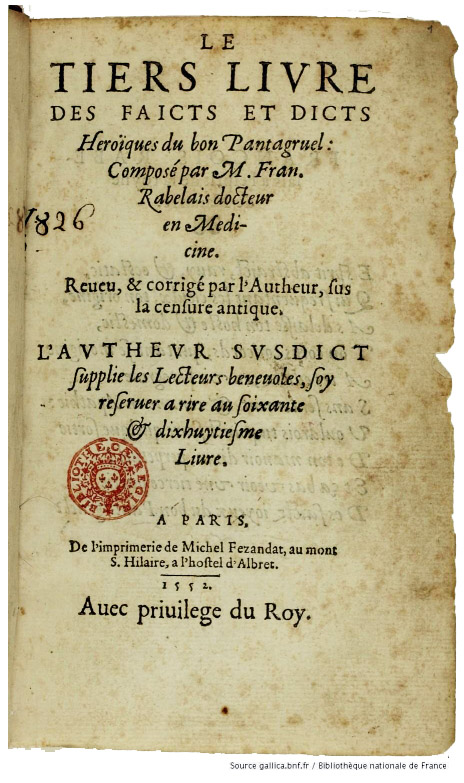 Rabelais published the first edition of Le Tiers livre des Faicts et Dicts Heroïques du bon Pantagruel in 1546 and published a revised and corrected edition in 1552. The latter edition is the basis for the text on this website.
Rabelais published the first edition of Le Tiers livre des Faicts et Dicts Heroïques du bon Pantagruel in 1546 and published a revised and corrected edition in 1552. The latter edition is the basis for the text on this website.
The 1546 edition was prefaced with a notice that François I, king of France, granted to his friend Rabelais a six year privilege of being the sole publisher and seller of his works, which are “no less useful than delectable.” François died in 1547 and in 1552 his son Henry II extended the privilege in the same friendly terms to ten years.
Le
Tiers Livre
des Faicts et Dicts
Heroïques du bon Pantagruel:
Composé par M. Fran.
Rabelais docteur en Medi
cine.
Reueu, & corrigé par l’Autheur,ſus
la cenſure antique.
L’Avthevr svsdict
ſupplie les Lecteurs beneuoles, ſoy
reſeruer a rire au ſoixante
& dixhuytieſme
Liure.
A Paris,
De l’imprimerie de Michel Fezandat, au mont
S. Hilaire, a l’hoſtel d’Albret.
1552.
Auec priuilege du Roy.
The Third Book
of the Heroic Deeds and Sayings
of the Good Pantagruel:
Composed by Master François Rabelais,
doctor in medicine.
Revised and corrected by the Author,
under the ancient censure.
The aforesaid Author supplicates his
benevolent readers, to reserve from laughing
until the seventy-eighth book.
At Paris, from the imprint of Michel Fezandat,
at Mont S. Hilaire, at the hotel of Albret.
1552.
With privilege of the King.
The final four chapters of The Third Book (1552) treat of the herb Pantagruelion:
- Chapter 49 How Pantagruel made his preparations for taking to sea. And of the herb called Pantagruelion.
- Chapter 50 How the celebrated Pantagruelion should be prepared and put to use.
- Chapter 51 Why it is called Pantagruelion, and the admirable virtues thereof.
- Chapter 52 How a certain kind of Pantagruelion cannot be consumed by fire.
Notes
Livres censurés
Les précautions de Rabelais furent vaines. Pantagruel et Gargantua furent rangés sur las liste des livres à censurer, établi par les théologiens de la Sorbonne à l’intention du Parlement en 1543 et 1544. En 1544, les deux volumes figuèrent avec les oeuvres d’Érasme, de Marot et de Calvin sur le Catalogue des livres censurés. L’étaient-ils pour hérésie? Ils n’avaient pas été censurés auparavant, comme on l’a cru sans preuves exactes, et on les avait souvent réédités depuis 1533.